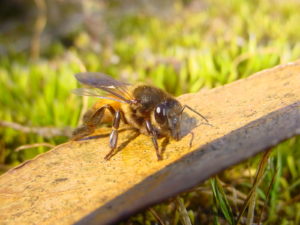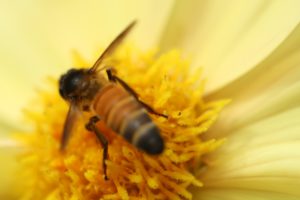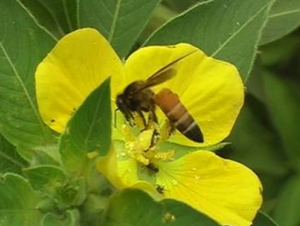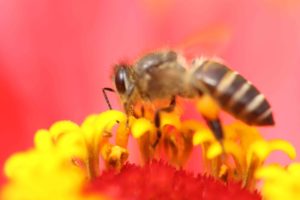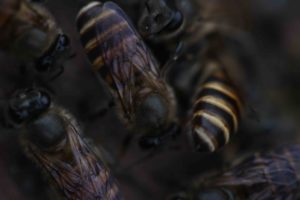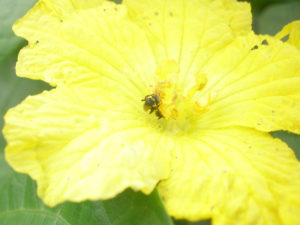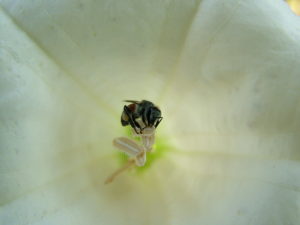There are four types of honeybee species found naturally in India. They vary in size, behavior, how they build nests, and there is even some variation in the Genus that they come from. Below is a list and simple description of each of the species:
The Giant Rock Bee (Apis dorsata)
Their name derives from the fact that they often construct their nests underneath rock overhangs, such as large cliff faces. However, they are not limited to steep escarpments but can also be found on high tree branches and the ceilings of large buildings. Often the Giant Rock will build its hives in aggregates, as in numerous colonies will construct their combs close to one another. For example, one large and sturdy tree can hold up to 100 colonies. When this honeybee constructs its nest it will do so within 1 km of a water source, and also tend to be near areas with plentiful pollen and nectar sources.
In addition, these nests are quite large and are required to be built vertically in order to hold the massive colony size, which ranges from ~60,000-100,000 worker bees. The Giant Rock Bee builds its nest out in the open, in order that the hive receives direct sunlight but is also kept protected from the rain (hence, often being underneath overhangs). Being the largest social bee in the Nilgiri Biosphere Reserve, as well as one of the largest honeybees in the world, this species produces large quantities of honey. In fact, the honey gathered from Apis dorsata contributes 2/3 of the total production of honey in India! On average, a single hive will give an annual yield of 2-40 kgs of honey. Within the Nilgiris, the Giant Rock Bee contributes to the majority of honey that is gathered by the local indigenous tribes as well.
There are even 2400 year old rock paintings of the honey hunters collecting honey from this bee, thus showing the long-held relationship between this honeybee and the people. The Giant Rock Bee is also notorious for being one of the most dangerous of bee species, and a colony will become very vicious if they feel their hive is being threatened. These honeybees are also able to migrate long distances (50-250 kms) and will travel to the plains when there is limited flowering in the mountains.
The Asian Honey Bee (Apis cerana)
The Asian Honey Bee is smaller in comparison to the Giant Rock Bee, however it is much more widespread. Typically the size range is 20,000-30,000 individuals per colony. This species does not nest out in the open but prefers dark enclosed places such as cavities within rocks, trees, stone walls, or even inside of buildings. In addition, as opposed to constructing a single comb this honeybee will build multiple, and construct it such that the outer combs hold the surplus honey while the inner combs hold the brood and pollen. The honey section a single hive can give an annual yield of 3-16 kgs of honey.
Even more so, the central comb also holds honey at the upper portion while the brood and pollen are found at the bottom of this central comb. They do not migrate naturally but will do so once honey is gone and they need to resupply food. Thus they will abscond the nest in the case of lack of resources or if there is a disturbance. The Asian Honey Bee is a generalist species thus it can adapt to multiple different landscapes as well as a large variety of plants. This species is distributed across all vegetation sites, however it does prefer the open canopy.
Another distinction from the Giant Rock Bee is that it has a much more mild temperament, nevertheless aggressiveness is possible, especially in correlation to large colony sizes. Albeit the gentler temper contributes to this honeybee being good for domestication and enables it to be hived relatively easily. In fact, beekeeping with this species has been practiced in India for nearly 2000 years. Nevertheless, there has to be constant maintenance when beekeeping with Apis cerana because it is prone to Thai Sac Brood Virus (TSBV). This species is not known to migrate but they will travel distance of 800 meters for foraging purposes.
The Little (or Dwarf) Honey Bee (Apis florea)
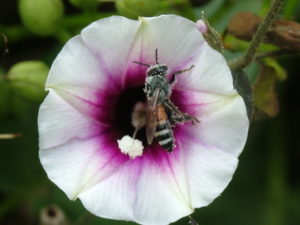
Another honeybee that builds single comb nests. These hives are found in dense, shrub vegetation as well as in cavities of rocks and trees, and even under the roofs of palm trees. When constructing the comb on a tree branch the Little Honey Bee often puts the honey at the upper region of the comb, which is placed on the top part of the branch, thus leaving the remaining part of the comb found below the branch to the brood, pollen, and drone cells. For best survival, a hive is often built very close to a water source and sticky resins are placed on the branch from which the comb hangs in order to keep away ants. The colony size of Apis florea often ranges between 8000-3,500 individuals. On average a single hive will produce 1-3 grams of honey in a season (typically from April to June).
If the hive is being disturbed this species will desert the nest, but only temporarily, and return shortly. Often Apis florea prefers an open habitat and a canopy that is broken up, along with medium size shrubbery, and can also be found under roofs or palm trees. Thus insinuating that this species may depend upon the vegetation. During the dearth period will also travel to the plains because the limited flowering in the fall yields to less honey. In fact, this honeybee will migrate locally at small distances of 500 meters and even as far as 20 kms. The honey from the Little Honey Bee will often sell at a higher price because it is reputed for medicinal properties.
Dammer Bees (Trigona spp and Melipona spp.)
This is the smallest of the honeybee species found in the Nilgiri Biosphere Reserve, as well as the world. They are also known as stingless bees because they do not sting but bite. They too build their nests in darker spaces such as trunks of trees, wall crevices, within logs, and even under roofs. They are also one of the honeybee species in the Nilgiri that people can do beekeeping with and there is a tradition in Tamil Nadu of keeping Dammer Bees insides of bamboo hives. From outside of the forest, people will also places pots in their houses and keep a Dammer Bee colony within. From this single pot, honey can be gathered for 5-8 years with a quantity of about 6 kilograms of honey each year. However, most often in the wild they produce about 1kgs – 20 grams of honey per hive. Hence, this bee makes for excellent domesticated species since it can be so easily hived and rarely absconds the nest.
When building a nest the Dammer Bees use propolis, also known as plant resins, along with wax. Within the hive there are specific cells for brood rearing while the larger sacs are designated for the storage of pollen and honey. The honey produced by this honeybee species is dark and bitter and is highly valued for its medicinal properties. In fact, when collected by the local tribes of the Nilgiris it is rarely sold to outsiders but rather preserved for children and pregnant women. Stingless bees are more commonly found in dry forests and diverse vegetation is considered to be important for this species. Their colony size ranges between 1500-100 individuals per hive.
Another intriguing feature of Dammer Bees is that they have a swarming and mating system that is unlike other Honey Bees. Once a queen bee larva has fully grown and emerged from the cell then a few drones will start to gather and transfer materials towards a new site in order to build a new nest. Pollen, along with honey, will then be carried over in honey sacs to this new nest. While this process is taking place the original queen of the parent colony will tolerate the young queen(s) and once the new nest site is prepared a new swarm(s) with the new queen(s) will transfer to this newly established hive.
